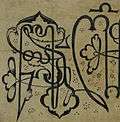Korean calligraphy
 |
| Part of a series on the |
| Culture of Korea |
|---|
| History |
|
Music and performing arts |
|
|
Monuments |
|
National symbols of Korea |
|
| Korean calligraphy | |
| Hangul | 서예 |
|---|---|
| Hanja | 書藝 |
| Revised Romanization | Seoye |
| McCune–Reischauer | Sŏye |


 |
| Calligraphy |
|---|
Korean calligraphy is the Korean tradition of artistic writing in Hangul or Hanja, respectively the Korean alphabet and Chinese characters. Hangul introduced the circle stroke.
History
Chinese characters were introduced to Korea as early as the 2nd or 3rd century AD, probably with the spread of Buddhism.[1] Admiration for Tang Dynasty culture, including Chinese calligraphy, grew during the Unified Silla period, and in the 8th century Kim Saeng became recognized as the earliest Korean calligraphic master, producing work that was compared with that of Wang Xizhi.[2] The poet Choe Chiwon was also known for his calligraphy, a sample of which is engraved in a rock in Haeundae, Busan.
The angular styles of the early Tang masters, Yu Shinan, Ouyang Xun, and Yan Zhenqing, persisted until the 14th century, when the more rounded style of Zhao Mengfu came into vogue.[1] Korean calligraphy became increasingly formalistic in the years that followed.[3] Kim Jung-hee revolutionized Korean calligraphy in the early 19th century, introducing what is known as the chusa style after his pen name 秋史, inspired by the ancient Chinese lishu script.
As the scholarly classes used Chinese characters, Korean calligraphy used hanja until the 1910–1945 Japanese occupation of Korea. Nationalist sentiment led to the popularization of the native hangul alphabet, and calligraphic works using hangul have since seen a revival.
The Korean calligraphy is developing its own style, steadfastly. Fonts that are not square are being developed, considering jong-sung, or sound coming after the vowel.
References
- 1 2 "Korean calligraphy", Encyclopedia Britannica, retrieved 2012-08-23
- ↑ Chen, Tingyou (March 3, 2011), Chinese Calligraphy, Cambridge University Press
- ↑ Yi, Ki-baek (1984), A New History of Korea, Harvard University Press